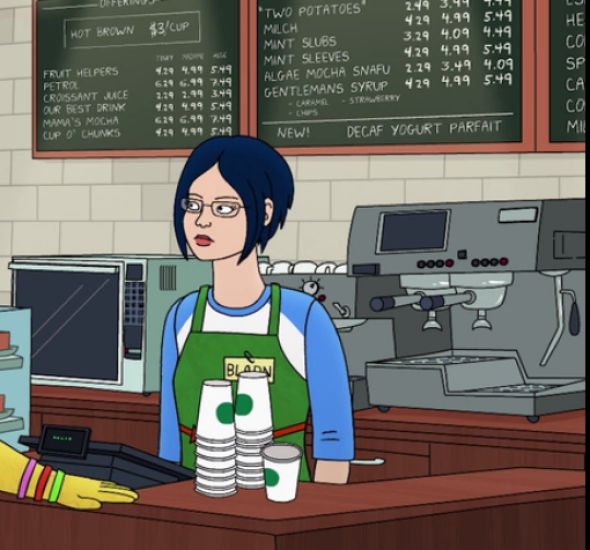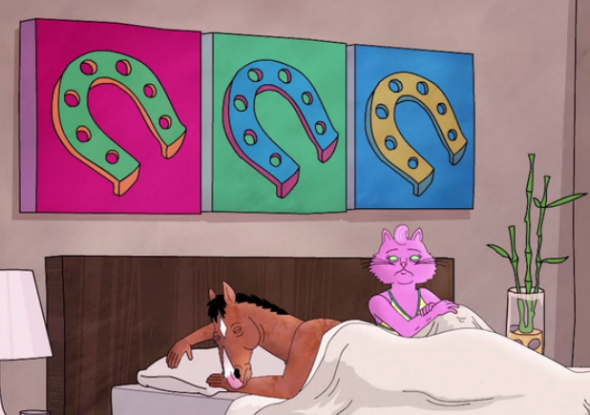Late in BoJack Horseman’s terrific third season, we stop into a kitchen where a panicked waiter has just been promoted to head chef, the rest of the staff having recently abandoned the premises. An array of imaginary cookbooks sits on a shelf behind him as he worries over the stove, their titles a testament to the show’s at once erudite and dopey sense of humor: No Rouxgrets, Philip Broth’s Big Book of Broths, and, perhaps most notably, the amusingly thick How to Cook Hot Dogs.

Netflix
Taken on their own, these background details barely count as jokes, especially in relation to the incisive, socially conscious wit of the show as a whole. But the design work at BoJack’s margins (another example in the scene above is the “First Aid for Choking” poster on which a rabbit person resuscitates a snake man) is actually key to the larger visual tone of the show—and to understanding the stylistic influence of Lisa Hanawalt.
An accomplished cartoonist who’s done illustration work for publications such as Lucky Peach, Hanawalt has also served as BoJack’s production designer since its first season. Though the Netflix animated series is collaborative through and through—a fact that Hanawalt is the first to acknowledge—her idiosyncratic voice is a defining one. The fake tome How to Cook Hot Dogs in particular seems like a deliberate nod to her own independent work, perhaps most notably her recent comics collection, Hot Dog Taste Test, the hand-lettered cover of which strikingly resembles the font on that fictional cookbook’s spine.
Considerably looser—and almost willfully rougher around the edges—than her work on BoJack, Hanawalt’s cartooning in Hot Dog Taste Test often varies stylistically from one page to the next. There are sequences that tell stories about anthropomorphic animals like those we meet on the show—tales of awkwardness and embarrassment that should resonate with the series’ admirers. But there are also almost improvisatory stretches, like one in which she frenetically pencils out a series of alternate slogans for corporate businesses: “Subway: Eat a Tube of Food.” “McDonald’s: I Love Something, Is It This?” “BMW: A Machine To Sit In.”

Lisa Hanawalt/Drawn and Quarterly
“I’m like a madwoman doing different styles of writing,” Hanawalt told me, “That’s the persona I get into.” But that playfully bonkers quality can’t quite make the leap to the foreground of television show, not least of all because in her role as production designer, she’s beholden to the work of countless other artists. That’s especially true, she says, for character designs, which she typically only renders in a single pose, before passing them onto the animators who bring those initial sketches to multidimensional life.
If there’s one area where Hanawalt’s personal aesthetic and tastes do come through, however, it’s on the edges of the frame. “When I’m writing my personal work is also when I’m filling in the background of BoJack with details,” she says, explaining that it’s there that her own ideas about what’s funny come through most clearly. She points in particular to a fake Starbucks menu that she crafted for the background of the new season’s second episode. Easy to miss, that menu is a master class of bemused surrealism, featuring a list of can’t-miss beverages that includes “croissant juice,” “algae mocha snafu,” and, puzzlingly, something simply called “two potatoes.”

Netflix
Fittingly, given BoJack’s underlying melancholy, not everything that Hanawalt tucks into the edges of the frames is a joke. “Sometimes when I’m filling in the background, I go back and look at painters that I love and try to capture their style,” she says. Start looking, and you’ll see them everywhere—a David Hockney in BoJack’s office, a version of Manet’s “Olympia” that features a reclining shark instead of a nude woman, a Basquiat triptych. “We joke that every character on this show is an art expert,” Hanawalt tells me. “But really it’s just me nerding out, and the whole crew has gotten into that.”

Netflix
Such details are, Hanawalt suggests, critical to the binge-watching experience that Netflix encourages. Though most of them will slip past us on a first, enthusiastic viewing, they slowly creep into our consciousness on our second, third, fourth passes through the season. “I want to draw something that will make people look again,” she said.

Netflix
